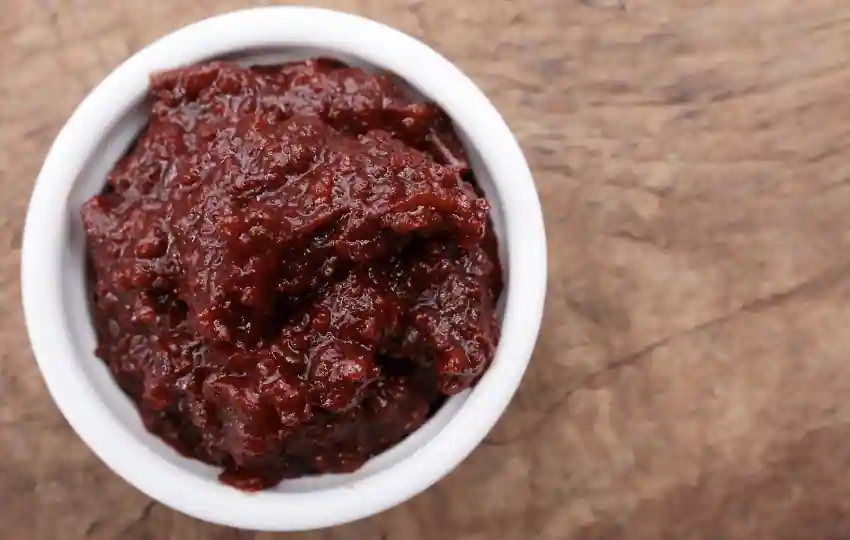Kimchi paste is an essential ingredient in Korean cuisine. It’s made from a variety of fermented vegetables and has a strong, pungent flavor.
If you don’t have kimchi paste on hand, or if you’re looking for a milder alternative, there are several substitute Kimchi Paste that will work just as well in your recipes.
What’s in kimchi paste? What does kimchi paste taste like?
Kimchi paste is a key ingredient in the popular Korean dish kimchi. The paste is made by blending chili peppers, garlic, ginger, and other spices.
This spicy mixture is then used to flavor the cabbage and other vegetables that are traditionally used in kimchi. The result is a dish that is both flavorful and tangy.
Kimchi paste can also be used as a condiment for other dishes, such as rice or noodles. For those who are curious about kimchi but have never tried it, kimchi paste is an excellent way to get a taste of this unique cuisine.
Read More- What can I use instead of kimchi fish sauce?
Best Substitute for Kimchi Paste
1. Gochujang – ideal Substitute for Kimchi Paste
Gochujang is a Korean chili paste that is made from chili peppers, glutinous rice, fermented soybeans, and salt. It has a similar flavor to kimchi paste, but it is much sweeter.
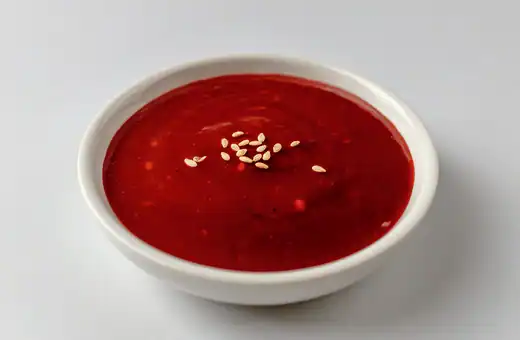
To substitute gochujang for kimchi paste, use the same amount of gochujang as you would kimchi paste. For example, if a recipe demands 1 tablespoon of kimchi paste, use 1 tablespoon of gochujang instead.
Gochujang can be found in most Asian markets or online.
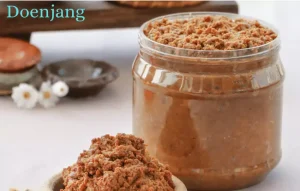
2. Doenjang+ with gochugaru (Korean chili flakes)
Doenjang is a Korean soybean paste that is made from fermented soybeans and brine. It has a nutty, earthy flavor and is less spicy than kimchi paste. Doenjang can be found in most Asian markets or online.
Doenjang + gochugaru is a great substitution for kimchi paste because it delivers the same bold flavor without being as spicy.
If you’re looking for milder kimchi, this substitution is a great option.
However, if you want your kimchi to be extra spicy, you can always add more gochugaru to the mixture. Simply taste the variety and add more gochugaru until it reaches the desired level of spiciness.
To substitute doenjang + gochugaru for kimchi paste, simply mix the two ingredients together in a bowl until they are well combined. Then, use this mixture in place of the kimchi paste in your recipe.
This substitution will work well in any recipe that calls for kimchi paste, so feel free to experiment!
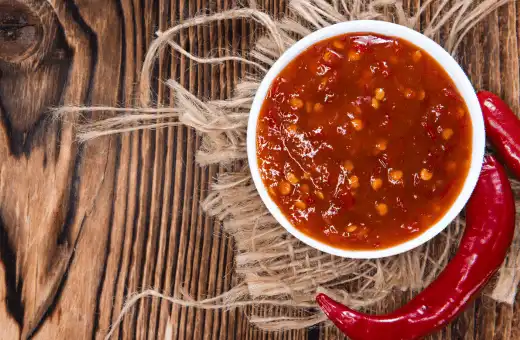
3. Sambal Oelek – Ideal alternative For Kimchi Paste
Sambal oelek is a kind of chili paste that originates from Indonesia. It is made from ground chilies, vinegar, and salt.
Unlike kimchi paste, which is often made with fermented vegetables, sambal oelek is not fermented.
This gives it a fresh, bright flavor that is perfect for adding a little spice to dishes. Sambal oelek can be used in place of kimchi paste in any recipe.
Just add it to the dish in the same amount as you would kimchi paste.
It can be used to add heat to soups, stews, and marinades. It is also a great condiment for grilled meats or vegetables. So next time you are searching for a little extra flavor, reach for the sambal oelek.
To substitute sambal oelek for kimchi paste, simply use a 1:1 ratio. So, if a recipe demands 1 tablespoon of kimchi paste, you would use 1 tablespoon of sambal oelek instead.
Remember that sambal oelek is usually quite a bit spicier than kimchi paste, so you may want to begin with less and add more to taste.
4. Try Chili Garlic Sauce instead of Kimchi Paste
Chili garlic sauce is a Chinese condiment that is made from chili peppers, garlic, oil, and vinegar. It has a similar flavor to kimchi paste and can be found in most Asian markets or online.
To substitute Chili Garlic Sauce for kimchi paste, simply use the same amount of Chili Garlic Sauce as you would kimchi paste.
For example, if a recipe demands 1 tablespoon of kimchi paste, use 1 tablespoon of Chili Garlic Sauce instead.
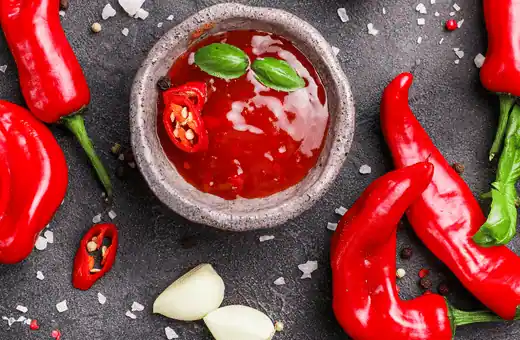
If you cannot find chili garlic sauce, you can also make your own. To make your own chili garlic sauce, chop up some fresh chili peppers and garlic.
Then, mix these ingredients together with some salt, sugar, and vinegar. Let the mixture sit for a few hours to allow the flavors to meld. Once the mixture is ready, use it in place of kimchi paste in any recipe.

5. Sriracha – great replacement For Kimchi Paste
If you cannot find either kimchi paste or gochujang, you can try using sriracha sauce as a kimchi paste substitute.
Sriracha is a Thai chili sauce that is made from chili peppers, vinegar, garlic, sugar, and salt. It has a similar flavor to kimchi paste and gochujang.
To substitute sriracha for kimchi paste, use the same amount of sriracha as you would kimchi paste. For example, if a recipe demands 1 tablespoon of kimchi paste, use 1 tablespoon of sriracha instead.
Sriracha can be found in most Asian markets or online.
Conclusion on substitute for kimchi paste
Kimchi paste is a key ingredient in many Korean dishes.
If you don’t have any on hand, there are several substitutes that will work just as well.
Gochujang, sambal oelek, and chili garlic sauce are all great substitutes for kimchi paste. You can find them in most Asian markets or online.
FAQ’s on substitute for kimchi paste
Q1. Is kimchi paste the same as gochujang?
Kimchi paste and gochujang are both fermented chili pastes that are commonly used in Korean cuisine. While they share some similarities, there’re also some important dissimilarities between the two.
Gochujang is made with red chili peppers, glutinous rice, fermented soybeans, and salt. It is typically milder than kimchi paste and has a sweeter flavor.
Kimchi paste, on the other hand, is made with cabbage, radishes, green onions, garlic, ginger, and red chili peppers. It is usually quite spicy and has a much more intense flavor than gochujang.
So, while kimchi paste and gochujang both have their place in Korean cuisine, they are not interchangeable. When cooking with either of these ingredients, be sure to use the one that best suits your dish.
Q2. How do you substitute kimchi juice?
Kimchi juice is a key ingredient in many Korean dishes, providing both flavor and a probiotic punch. While it can be difficult to find outside of Asia, there are a few substitutes that can be used in a pinch.
The simplest replacement is to mix together equal parts gochujang (Korean chili paste) and rice vinegar. This combination will give you the acidity and spice of kimchi juice without the fermented flavor.
If you’re looking for something closer to the real thing, you can try substituting pickle juice or sauerkraut brine. Both of these options will provide the desired tang, but they may be too salty for some recipes. As always, use your best judgment when substituting ingredients in your cooking.
Q3. Can I use soy sauce for kimchi paste?
If you’re in a pinch and need a kimchi paste substitute, soy sauce can work in a pinch. However, it’s important to note that soy sauce is much saltier than traditional kimchi paste, so you’ll need to use less of it.
In addition, soy sauce doesn’t have the same depth of flavor as kimchi paste, so your kimchi may not be quite as flavorful as it would be if you used the traditional ingredient.
If you do decide to use soy sauce as a substitute for kimchi paste, be sure to taste it before adding it to your dish so that you can adjust the amount accordingly.
Q4. Can you make kimchi without shrimp paste?
When most people think of kimchi, they think of the traditional Korean dish that is made with fermented cabbage and a variety of other vegetables. However, many people don’t realize that kimchi can be made without any shrimp paste.
Although shrimp paste is a key ingredient in many kimchi recipes, it is not necessary for the fermentation process. In fact, there are many delicious vegetarian and vegan kimchi recipes that do not include shrimp paste. If you want to make kimchi without shrimp paste, you should keep a few things in mind.
First, you will need to use different fermentation starters, such as kefir or yogurt. Second, you may need to adjust the ratio of vegetables to ensure that the kimchi has the right amount of crunchiness.
Finally, remember that kimchi without shrimp paste will have a slightly different flavor than traditional kimchi. However, if made correctly, it can be just as delicious.

